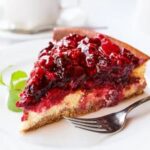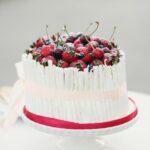What type of icing is used to decorate cakes? Icing plays a crucial role in cake decoration, enhancing not only the overall look but also the taste of the cake. From buttercream to royal icing, fondant, ganache, and cream cheese icing, each type offers unique characteristics for creating stunning cake designs. Understanding the different types of icing and their applications can help elevate your cake decorating skills and add a special touch to any occasion.
Icing is more than just a finishing touch on a cake; it can transform a simple dessert into a work of art. The right choice of icing can complement the flavor of the cake and bring your creative vision to life. Whether you’re aiming for smooth texture, intricate designs, or rich decadence, choosing the appropriate type of icing is essential in achieving your desired results.
In this article, we will explore various types of icing used in cake decorating, including buttercream, royal icing, fondant, ganache, and cream cheese icing. Each type has its own unique properties and applications in creating beautiful and delicious works of confectionery art. So let’s delve into the world of cake decorating and discover how different types of icing can elevate your baking game.
Types of Icing
When it comes to cake decoration, the type of icing used plays a crucial role in determining the overall look, texture, and taste of the cake. There are several different types of icing that are commonly used in cake decorating, each with its own unique properties and applications. Understanding the characteristics of these various types of icing is essential for creating beautiful and delicious cakes.
Here are the different types of icing used in cake decorating:
- Buttercream: This type of icing is a popular choice for cake decoration due to its smooth texture and versatility. It can be easily colored and flavored, making it ideal for creating various designs, from simple swirls to intricate patterns.
- Royal icing: Known for its hardening properties, royal icing is often used to create elaborate decorations on cakes. It dries to a smooth, glossy finish, making it suitable for intricate piping work and delicate designs.
- Fondant: Fondant icing is prized for its smooth and sleek appearance, making it perfect for creating detailed and elaborate cake decorations. It can be rolled out into thin sheets and draped over cakes to achieve a flawless finish.
- Ganache: With its rich and glossy finish, ganache is often used to create decadent and indulgent cake decorations. It can be poured over cakes for a smooth coating or whipped into a fluffy frosting for a luxurious touch.
- Cream cheese icing: This type of icing has a creamy and tangy flavor, making it perfect for both simple and elaborate cake designs. It pairs well with a variety of flavors and can be easily spread or piped onto cakes.
By understanding the characteristics and applications of these different types of icing, you can choose the right one based on the type of cake, design, and occasion. Whether you’re aiming for a classic buttercream-frosted birthday cake or an intricately decorated fondant-covered wedding cake, selecting the appropriate icing is essential for achieving your desired result.
Buttercream Icing
Introduction to Buttercream Icing
Buttercream icing is one of the most popular types of icing used in cake decorating due to its smooth texture and versatility in creating various designs and styles. It is made from a combination of butter, powdered sugar, flavorings, and sometimes milk or cream. This type of icing can be easily colored and flavored, making it suitable for a wide range of cake designs and flavor preferences.
Smooth Texture and Versatility
One of the key characteristics of buttercream icing is its smooth texture, which allows for seamless application on cakes. Whether it’s creating simple swirls, intricate piping details, or smooth finishes, buttercream offers decorators the flexibility to bring their creative vision to life. This type of icing also lends itself well to both classic and contemporary cake designs, making it a go-to choice for many bakers.
Creative Designs With Buttercream
Buttercream icing is known for its ability to hold intricate designs such as ruffles, flowers, rosettes, and other decorative elements. Its pliability allows decorators to create beautiful textures and patterns that add visual interest to cakes. Additionally, buttercream can be used as a base layer for fondant decorations or as a standalone medium for creating stunning edible art on cakes.
When deciding what type of icing is used to decorate cakes, buttercream is often the top choice due to its adaptability in design and its delicious taste that complements a variety of cake flavors.
Royal Icing
Hardening Properties
One of the most notable features of royal icing is its ability to harden when left to dry. This makes it perfect for creating three-dimensional decorations such as flowers, lacework, and intricate patterns.
The hardened finish also provides stability and durability to the decorations, allowing them to hold their shape and structure over time. Whether it’s used for piping delicate borders or crafting elaborate figurines, royal icing’s hardening properties make it a go-to choice for professional bakers and decorators.
Creating Intricate Designs
Royal icing’s ability to set firmly makes it well-suited for creating detailed designs on cakes. From elegant lacework patterns to ornate filigree designs, this type of icing allows decorators to showcase their artistry and skill in producing fine, detailed work that adds a touch of sophistication and refinement to any cake.
Its smooth consistency and ability to be piped into intricate shapes also make royal icing an excellent choice for adding personalized touches like monograms or messages on special occasion cakes.
Versatility in Application
Aside from its use in creating decorations, royal icing can also be utilized as an adhesive for attaching edible embellishments such as sugar pearls, dragees, or edible glitter onto cakes and confections. Its firm texture makes it an ideal “glue” for securing lightweight decorations in place without compromising the design or appearance. Additionally, royal icing can be tinted with food coloring to achieve custom shades and hues, further expanding its versatility in cake decorating.
Fondant
One of the key advantages of fondant icing is its versatility in creating a variety of shapes, figures, and patterns. It can be molded and sculpted to form 3D designs or cut into different shapes using cookie cutters or molds.
This makes fondant an excellent choice for creating custom decorations that match the theme or style of the event. Whether it’s elegant flowers, intricate lace patterns, or playful figurines, fondant allows for endless possibilities when it comes to cake decoration.
In addition to its visual appeal, fondant icing also offers the benefit of providing a protective layer for the cake. Due to its pliable nature, fondant acts as a barrier against air and moisture, helping to keep the cake fresh and moist for longer periods.
This makes it especially suitable for tiered cakes that need to be assembled in advance or transported to different locations. Overall, fondant icing is a versatile option that adds a touch of sophistication and artistry to cake decoration, making it a top choice for professional bakers and home decorators alike.
Ganache
When it comes to cake decoration, ganache icing is a popular choice for creating a rich and glossy finish that adds a decadent touch to any cake. Made from a combination of chocolate and cream, ganache has a smooth and velvety texture that makes it ideal for both filling and frosting cakes. Its versatility allows for various decorating techniques, making it a favorite among bakers and pastry chefs.
One of the key characteristics of ganache icing is its luxurious appearance when spread onto cakes. The shiny and reflective surface of ganache adds an elegant touch to any dessert, making it suitable for special occasions such as weddings, birthdays, or formal events. Whether used as a simple glaze or as part of intricate decorations, ganache elevates the overall aesthetic appeal of the cake.
In addition to its visual appeal, ganache also contributes to the indulgent taste of the cake. The combination of high-quality chocolate and cream results in a luscious and creamy texture that enhances the flavor profile of the dessert.
Whether paired with rich chocolate cakes or complementing lighter flavors such as vanilla or raspberry, ganache adds a layer of depth and richness to the overall taste experience. When considering what type of icing is used to decorate cakes, ganache certainly stands out as an excellent choice for creating a truly indulgent and memorable dessert.
Cream Cheese Icing
One of the key features of cream cheese icing is its versatility in terms of flavor and appearance. By adjusting the ratio of cream cheese to butter and sugar, it is possible to achieve different consistencies and sweetness levels to suit individual preferences.
Additionally, cream cheese icing can be easily flavored with extracts or citrus zest to add depth and complexity to its taste. From classic vanilla-flavored cream cheese icing to more adventurous options like lemon or orange-infused icing, the possibilities for customization are endless.
In terms of decorating capabilities, cream cheese frosting can be piped into intricate designs or simply spread over the surface of the cake for a rustic yet elegant look. Its natural off-white color provides a neutral canvas for adding food coloring or edible decorations, making it suitable for themed cakes and special occasions.
Whether used as an accompaniment to red velvet cake or as an unexpected pairing with fruit-flavored cakes such as carrot or pumpkin, cream cheese icing adds a unique touch that elevates the overall presentation and enjoyment of the cake.
| Cream Cheese Icing | Attributes |
|---|---|
| Texture | Smooth and spreadable |
| Flavor Variations | Vanilla, lemon, orange |
| Decorating Capabilities | Piping intricate designs or spreading for a rustic look |
Tips for Choosing the Right Icing
There are several factors to consider when choosing the right icing for cake decoration. The type of cake, design, and occasion all play a crucial role in determining the most suitable icing for your creation. One of the key considerations is the flavor of the icing.
Some icings, such as buttercream and cream cheese, offer a rich and creamy flavor that complements a variety of cake flavors, while others like royal icing are sweeter and more traditional. It’s important to choose an icing that will enhance the overall taste of the cake and not overpower it.
Another important factor to consider is the design you have in mind for your cake. For intricate designs and decorative details, royal icing or fondant may be more suitable due to their smooth and hardening properties, which make them ideal for creating elaborate decorations. On the other hand, if you’re going for a simpler design or prefer a more rustic look, buttercream or ganache may be better options as they can create softer and more textured finishes.
The occasion also plays a significant role in selecting the right icing for your cake decoration. For example, if you are making a wedding cake, fondant or royal icing might be preferred because of their ability to create elegant and sophisticated designs. Conversely, for a children’s birthday cake, buttercream or cream cheese icing could be more suitable due to their versatility in creating fun and colorful decorations that appeal to younger audiences.
| Factors | Icing Types |
|---|---|
| Flavor | Buttercream, Royal Icing, Fondant, Ganache Cream Cheese Icing |
| Design | Royal Icing or Fondant for intricate designs; Buttercream or Ganache for simpler designs |
| Occasion | Fondant or Royal Icing for weddings; Buttercream or Cream Cheese Icing for children’s birthdays |
Conclusion
In conclusion, the type of icing used to decorate cakes plays a pivotal role in enhancing not only the visual appeal but also the taste of the cake. Whether it’s the smooth and versatile buttercream, the intricate royal icing, the sleek and detailed fondant, the rich ganache, or the creamy cream cheese icing, each type offers unique qualities that can elevate the overall presentation and enjoyment of a cake.
Choosing the right icing is crucial as it can make or break the final outcome of a cake decoration.
The selection of icing depends on various factors such as the type of cake being decorated, the desired design and style, and the occasion for which it is being prepared. Understanding these considerations and tips for choosing the right icing can lead to a successful cake decoration that meets both aesthetic and gustatory expectations. It’s important to consider factors such as flavor, texture, stability, and design when making this decision.
Ultimately, whether it’s a simple yet elegant design or an elaborate and detailed creation, selecting the appropriate icing will define the overall look and feel of a cake. The right choice can result in a visually stunning masterpiece that delights both eyes and palate. Therefore, understanding what type of icing is used to decorate cakes is essential for achieving aesthetically pleasing and delicious results in cake decorating.
Frequently Asked Questions
What Kind of Frosting Do You Use to Decorate Cakes?
The kind of frosting commonly used to decorate cakes is buttercream. It is a versatile and easy-to-work-with frosting that can be flavored and colored as desired, making it popular among bakers and decorators.
What Are the 5 Most Commonly Used Icings for Cakes?
The five most commonly used icings for cakes are buttercream, fondant, royal icing, ganache, and cream cheese frosting. Each type of icing offers different flavors, textures, and decorative possibilities for cakes.
What Kind of Icing Do Professionals Use?
Professionals often use Swiss meringue buttercream or Italian meringue buttercream for their cakes. These types of frostings are known for their smooth texture, stability, and ability to hold intricate designs, making them ideal for professional cake decoration work.

Welcome to my blog about home and family. This blog is a place where I will share my thoughts, ideas, and experiences related to these important topics. I am a stay-at-home mom with two young children. I hope you enjoy reading it! and may find some helpful tips and ideas that will make your home and family life even better!





